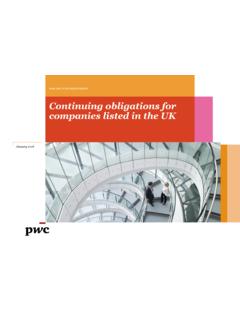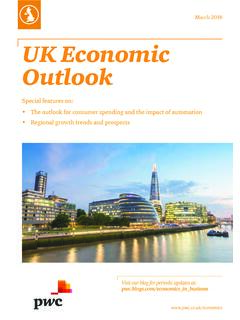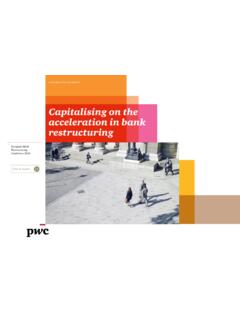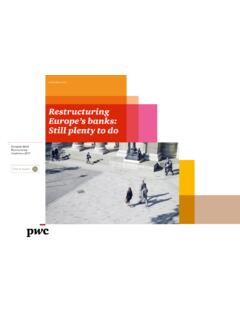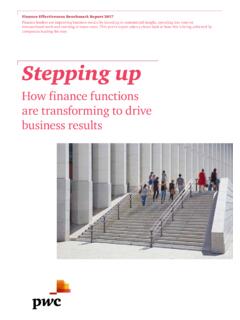Transcription of Will robots really steal our jobs? - PwC UK
1 Will robots really steal our jobs? An international analysis of the potential long term impact of automation Key findings: impact of automation Financial services jobs could be relatively vulnerable to automation in the shorter term, while transport jobs are more vulnerable to automation in the longer term Figure 1 Potential job automation rates by industry across waves Source: PwC estimates based on OECD PIAAC data (median values for 29 countries) In the long run, less well educated workers could be particularly exposed to automation, emphasising the importance of increased investment in lifelong learning and retraining Figure 2 Potential job automation rates by education level across waves Source.
2 PwC estimates based on OECD PIAAC data (median values for 29 countries) Female workers could be more affected by automation over the next decade, but male jobs could be more at risk in the longer term Figure 3 Potential job automation rates by gender across waves Source: PwC estimates based on OECD PIAAC data (median values for 29 countries) Waves Description and impact Wave 1: Algorithmic wave (to early 2020s) Automation of simple computational tasks and analysis of structured data, affecting data-driven sectors such as financial services. Wave 2: Augmentation wave (to late 2020s) Dynamic interaction with technology for clerical support and decision making.
3 Also includes robotic tasks in semi-controlled environments such as moving objects in warehouses. Wave 3: Autonomous wave (to mid-2030s) Automation of physical labour and manual dexterity, and problem solving in dynamic real-world situations that require responsive actions, such as in transport and construction. 0%10%20%30%40%50%Wave 1(to early 2020s)Wave 2(to late 2020s)Wave 3(to mid-2030s)% of existing jobs at potential risk of automationTransportFinancial servicesAll sectorsHealth0%10%20%30%40%50%Wave 1(to early 2020s)Wave 2(to late 2020s)Wave 3(to mid-2030s)% of existing jobs at potential risk of automationLow educationMedium educationHigh education0%5%10%15%20%25%30%35%Wave 1(to early 2020s)Wave 2(to late 2020s)Wave 3(to mid-2030s)% of existing jobs at potential risk of automationMenAllWomenWill robots really steal our jobs?
4 An international analysis of the potential long term impact of automation PwC Contents 1. Summary 1 2. Introduction 7 3. How do potential automation rates vary by country? 9 Estimated potential automation rates across countries 9 The relative impact of industry composition and job automatability 10 Factors related to estimated automation levels 11 Impact on countries over time the three waves of automation 14 Two important caveats constraints on automation and new job creation 17 4. Which industry sectors could see the highest rates of automation? 18 Total automation rates across industries 18 Impact on industries over time 20 Drivers of differences between industries 21 Which sectors are likely to see the largest jobs gains?
5 22 5. Which occupations could see the highest rates of automation? 23 Total automation risk across occupation categories 23 Impact over time by occupation 24 Drivers of differences between occupations 25 Composition of industries by occupational category 26 6. Why does the potential rate of job automation vary by type of worker? 27 Total automation risk across workers 27 Potential automation rates by education level 30 7. What are the public policy implications? 34 Education and skills 34 Job creation through increased public and private investment 34 Enhancing social safety nets 35 8.
6 Implications for business: constraints, opportunities and responsibilities 36 What constraints will need to be overcome to realise benefits for business? 36 AI s impact on company value chains 37 AI and healthcare provision 38 Businesses need to help workers retrain and adapt to new technologies 39 Conclusion 39 Annex technical methodology 40 References 41 Authors, contacts and services 43 Contents Will robots really steal our jobs? An international analysis of the potential long term impact of automation PwC 1 Artificial intelligence (AI), robotics and other forms of smart automation are advancing at a rapid pace and have the potential to bring great benefits to the economy, by boosting productivity and creating new and better products and services.
7 In an earlier study1, we estimated that these technologies could contribute up to 14% to global GDP by 2030, equivalent to around $15 trillion at today s values. For advanced economies like the US, the EU and Japan, these technologies could hold the key to reversing the slump in productivity growth seen since the global financial crisis. But they could also produce a lot of disruption, not least to the jobs market. Indeed a recent global PwC survey2 found that 37% of workers were worried about the possibility of losing their jobs due to automation. To explore this further we have analysed a dataset compiled by the OECD that looks in detail at the tasks involved in the jobs of over 200,000 workers across 29 countries (27 from the OECD plus Singapore and Russia).
8 Building on previous research by Frey and Osborne (Oxford University, 2013)3 and Arntz, Gregory and Zierahn (OECD, 2016)4 we estimated the proportion of existing jobs that might be of high risk of automation by the 2030s for: Each of these 29 countries; Different industry sectors; Occupations within industries; and Workers of different genders, ages and education levels. We also identify how this process might unfold over the period to the 2030s in three overlapping waves: 1. Algorithm wave: focused on automation of simple computational tasks and analysis of structured data in areas like finance, information and communications this is already well underway.
9 2. Augmentation wave: focused on automation of repeatable tasks such as filling in forms, communicating and exchanging information through dynamic technological support, and statistical analysis of unstructured data in semi-controlled environments such as aerial drones and robots in warehouses this is also underway, but is likely to come to full maturity in the 2020s. 3. Autonomy wave: focused on automation of physical labour and manual dexterity, and problem solving in dynamic real-world situations that require responsive actions, such as in manufacturing and transport ( driverless vehicles) these technologies are under development already, but may only come to full maturity on an economy-wide scale in the 2030s.
10 Our estimates are based primarily on the technical feasibility of automation, so in practice the actual extent of automation may be less, due to a variety of economic, legal, regulatory and organisational constraints. Just because something can be automated in theory does not mean it will be economically or politically viable in practice. 1 PwC, Sizing the prize (2017): 2 PwC, Workforce of the future (2017): 3 Frey, and Osborne (2013), The Future of Employment: How Susceptible are Jobs to Computerisation?, University of Oxford.
